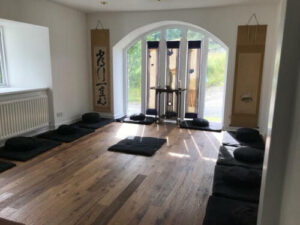It had been 10 years since my last sesshin at Fell End. In the intervening years I had continued my practice ploughing a lone furrow but with regular contact with Suigen Sensei, my teacher. Like many Sangha members, I experienced immense support through sitting via Zoom from pandemic times onward.
My world had changed during this time too, when my wife, Jen, was diagnosed with cancer, a battle which continued for 6 years ending in her passing late in 2022. Those years of caring and hope had been the focus of my practice, looking for the possibility of a positive outcome. I knew that there was an inevitability that the suffering would end for Jen, through her death.
However, knowing this in some sort of abstract intellectual way, didn’t prepare me for the acute emotional pain and physical suffering I experienced. I wasn’t able to find any solace, only turmoil, in practice. I spent the time trying to keep the attachment to her alive, by a constant round of visiting mutual friends, looking at photos of our time together and endlessly playing her favourite music. Just as I am emerging from this process, my and Suigen’s dear friend and best man, Joe, died suddenly. Two pillars of my life removed in the space of six months. I was back in the maelstrom. I had decided that a sesshin would give me the opportunity to focus, to really explore the nature of the four noble truths, to take on their meaning and see if I was able to truly engage in Zen practice.
So I duly arrive at Fell End, nervous but full of positive intent. Being thrust together with other members of the sangha, most of whom I only know from Zoom, is an unusual experience. I have been leading a life of isolation so my interaction skills are limited. The anticipation, the energy, the willingness to share and engage emanating from everyone allays the initial fears I have. Getting into the routines of the sesshin takes time. It’s one thing to know the order of the day, quite another to experience it. I say this, because for me the more mundane aspects of finding a position in the zendo, remembering the form, keeping my natural urge to speak under control, all crowd in to my head. My natural curiosity about other sangha members and their motivations for being there also takes time to subjugate. Finally able to settle, somewhere towards the end of the first full day I try to turn my mind to the issue I want to explore, my ostensible motive for being there. But, of course, it just doesn’t work like that. The more I try to focus on suffering, attachment and impermanence the further away they seem to go. Instead the driver is to something seemingly more simple, yet really challenging, concentrating on breath. Once I start to let go of the attachment to wanting answers, the experience becomes more fluid and open. The flow and rhythm of the daily routines, from early tea, periods of zazen interspersed with samu and individual reflection to lights out, creates a gentling effect on me. I am awakened to the myriad individual journeys of the sangha members, looking up and beyond my selfish motivations. The communal intimacy of zazen, the inclusive nature of mundane tasks of cleaning, cooking, eating and clearing up, all create an invisible bond, an engagement at a primary level of care. As this works out through the week, so I become more aware of changes in me. My desire to meditate on my pain and suffering comes up against blocks, mental or emotional? I am not sure. Interview leads me to be less hard on myself, a reminder that kindness to self as well as others will help. By Thursday I sense something is in my grasp. At service Suigen Sensei and I are given the opportunity to offer incense for both Jen & Joe. The power of this overwhelms me. The floodgates open and I sit for 1? 2? more? hours shedding the tears of attachment.
Reliving this now, I realise that what happened was a physical manifestation of where my meditation had been leading me. I had come to recognise and accept impermanence in a very real and personal way. That in itself has allowed me to dissipate some of the suffering. I am very conscious that bereavement is spiky, twisty rather than a linear process, so yes the attachment and suffering are still around, but more accepted for what they are. They have become part of my practice, but not inhibitors to it. That same evening, we experience the joy of Jukai, for five sangha members. The power of this ceremony creeps in to my suffering of sadness. It is impossible not to be buoyed by the palpable, positive energy around.
The following afternoon I do what has become the usual walk along the river. My senses are heightened as I pick up on birdsong, the sighting of red squirrels and the languid flight of a heron. I watch some of the natural flotsam in the river, twigs and branches, swirling in the eddies of the stream. All are buoyed up, none sink. This image is my abiding one of this sesshin. It says to me that whilst individuals come together from different paths with myriad different personal concerns, practice and sangha sustain them, keep them afloat.
So the river of life keeps flowing. The three treasures take us further along the way. Their power, so manifest in this week of sesshin, sustains me in my practice.

